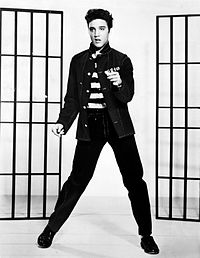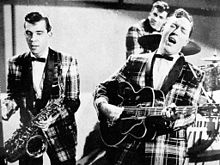- Music history of the United States (1940s and 50s)
-
United States music history - Colonial era
- to the Civil War
- During the Civil War
- Late 19th century
- Early 20th century
- 1940s and 50s
- 1960s
- 1970s
- 1980s
- 1990s
- 2000s
- 2010s
Ethnic musicUnited States Many musical styles flourished and combined in the 1940s and 1950s, most likely because of the influence of radio had in creating a mass market for music. World War II caused great social upheaval, and the music of this period shows the effects of that upheaval.
Contents
Rock and roll
 Elvis Presley, 1957
Elvis Presley, 1957 Bill Haley & His Comets, circa 1955
Bill Haley & His Comets, circa 1955
In the 1940s, the major strands of American music combined to form what would eventually be coined as rock and roll. Based most strongly off an electric guitar-based version of the Chicago blues, rock also incorporated jazz, pop, country, folk, swing, and other types of music; in particular, bebop jazz and boogie woogie blues were in vogue and greatly influenced the music style. The style had developed by 1949, and quickly became popular among blacks nationwide (see 1949 in music). Mainstream success was slow to develop, though (in spite of early success with Bill Haley & His Comets' "Rock Around the Clock"), and didn't begin in earnest until Elvis Presley ("Hound Dog") began singing rock, R&B and rockabilly songs in a devoted black style. He quickly became the most famous and best-selling artist in American history, and a watershed point in the development of music.
Chuck Berry refined and developed rhythm and blues into the major elements that made rock and roll distinctive, with lyrics focusing on teen life and consumerism, and utilising guitar solos and showmanship that would be a major influence on subsequent rock music.[1]
Bluegrass
In the late 1930s, Bill Monroe formed the Blue Grass Boys (named after his native state of Kentucky,the blue grass state) and combined diverse influences into Appalachian folk music. These include Scottish, Poland and Southeastern Europe and folk, as well as doo wop, country and gospel. Monroe became the father of bluegrass music, and his band was a training ground for most of bluegrass' future stars, especially Lester Flatt and Earl Scruggs. Flatt and Scruggs popularized bluegrass as part of the Foggy Mountain Boys, which they formed in 1948. Though bluegrass has never quite achieved mainstream status, it did become well-known through its use in several recorded plays, including the T.V. theme song for Beverly Hillbillies and the movies Bonnie and Clyde and Deliverance. In the 1950s, bluegrass artists included Stanley Brothers, Osborne Brothers and Jimmy Martin's Sunny Mountain Boys.
Pop music
Dominating the airwaves in the early 1950s the Popular music crooners gave way to Rock N' Roll by the mid-1950s. Mainstream Popular Music and Country music stars in the early 1950s featured vocalists like Frank Sinatra, Tony Bennett, Frankie Laine, Patti Page, Hank Williams, Patsy Cline, Judy Garland, Johnnie Ray, Kay Starr, Bill Monroe, Eddy Arnold, Perry Como, Bing Crosby, Rosemary Clooney, Édith Piaf, Charles Aznavour, Maurice Chevalier, Gene Autry, Tex Ritter, Jimmy Durante, Georgia Gibbs, Eddie Fisher, Pearl Bailey, Jim Reeves, Teresa Brewer, Dinah Shore, Sammy Davis Jr., Tennessee Ernie Ford, Loretta Lynn, Chet Atkins, Guy Mitchell, Nat King Cole, and vocal groups like The Mills Brothers, The Ink Spots, The Four Lads, The Four Aces, The Chordettes, The Jordanaires, and The Ames Brothers.
Country music
The 1950s also saw the popular dominance of the Nashville sound in country music. Country's Nashville sound was slick and soulful, and a movement of rough honky tonk developed in a reaction against the mainstream orientation of Nashville. This movement was centered in Bakersfield, California with musicians like Buck Owens ("Act Naturally"), Merle Haggard ("Sing a Sad Song") and Wynn Stewart ("It's Such a Pretty World Today") helping to define the sound among the community, made up primarily of Oklahoman immigrants to California, who had fled unemployment and drought. A similarly hard-edged sound also arose in Lubbock, Texas (Lubbock sound).
Folk music
Main article: American folk music revivalThe late 1940s and the early 1950s saw the beginning of popular folk music with groups like The Weavers. The Kingston Trio, Pete Seeger, Woodie Guthrie, Odetta, and several other performers were instrumental in launching the folk music revival of the 1950s and 1960s.
Roots revival
By the late 1950s, a revival of Appalachian folk music was taking place across the country, and bands like The Weavers were paving the way for future mainstream stars like Bob Dylan and Joan Baez. Bluegrass was similarly revitalized and updated by artists including Tony Rice, Clarence White, Richard Green, Bill Keith and David Grisman. The Dillards, however, were the ones to break bluegrass into mainstream markets in the early 1960s.
Gospel
Following World War II, gospel began its golden age. Artists like the Five Blind Boys of Mississippi, The Swan Silvertones, Clara Ward Singers and Sensational Nightingales became stars across the country; other early artists like Sam Cooke, Dionne Warwick, Dinah Washington, Johnnie Taylor, Aretha Franklin, Wilson Pickett began their career in gospel quartets during this period, only to achieve even greater fame in the '60s as the pioneers of soul music, itself a secularized, R&B-influenced form of gospel. Mahalia Jackson and The Staple Singers were undoubtedly the most successful of the golden age gospel artists.
Doo wop
In addition, doo wop achieved widespread popularity in the 1950s. Doo wop was a hormonaly complex style of choral singing that developed in the streets of major cities like Illinois, New York, and, most importantly, Baltimore. Doo Wop singers would work a cappella without backing instruments, and practice in hallways of their schools, apartment buildings, or alleys to achieve echo effects on their voices, and lyrics were generally innocent youthful observations on the upsides of teen love and romance. Groups like The Crows ("Gee"), The Orioles ("It's Too Soon to Know") and Brooklyn's Frankie Lymon & the Teenagers ("Why Do Fools Fall in Love") had a string of hit songs that brought the genre to chart domination by 1958 (see 1958 in music).
Latin music
Cuban mambo, chachachá and charanga bands enjoyed brief periods of popularity, and helped establish a viable Latin-American music industry, which led the way to the invention of salsa music among Cubans and Puerto Ricans in New York City in the 1970s. The '50s also saw success for Mexican ranchera divas, while a Mexican-American mariachi scene was developing on the West Coast, and Puerto Rican plena, Brazilian bossa nova and other Latin genres became popular.
Mexican-Texans had been playing conjunto music for decades by the end of World War 2, female duos created the first popular style of Mexican-American music, música norteña. Mexican romantic ballads called bolero were also popular, especially singers like the Queen of the Bolero, Chelo Silva. In the mid-1950s, when Mexican ranchera was used in Hollywood film soundtracks and the upper-class enjoyed stately orquestas Tejanas and conjunto evolved into a distinctively Mexican-American genre called Tejano. Artists of this era include Esteban Jordan, Tony de la Rosa and El Conjunto Bernal.
Cajun and Creole music
The 1940s saw a return to the roots of Cajun music, led by Iry LeJeune, Nathan Abshire and other artists, alongside musicians who incorporated rock and roll, including Laurence Walker and Aldus Roger. In the late 1940s, Clifton Chenier, a Creole, began playing an updated form of la la called zydeco. Zydeco was briefly popular among some mainstream listeners during the 1950s. Artists like Boozoo Chavis, Queen Ida, Rockin' Dopsie and Rockin' Sidney have continued to bring zydeco to national audiences in the following decades. Zydeco shows major influences from rock, and artists like Beau Jocque have combined other influences, including hip hop.
References
- ^ M. Campbell, ed., Popular Music in America: And the Beat Goes on (Cengage Learning, 3rd edn., 2008), pp. 168-9.
See also
- 1950s in music
- American music during World War II
- Essential American Recordings Survey
Categories:- American music history
- 20th century in music
Wikimedia Foundation. 2010.

